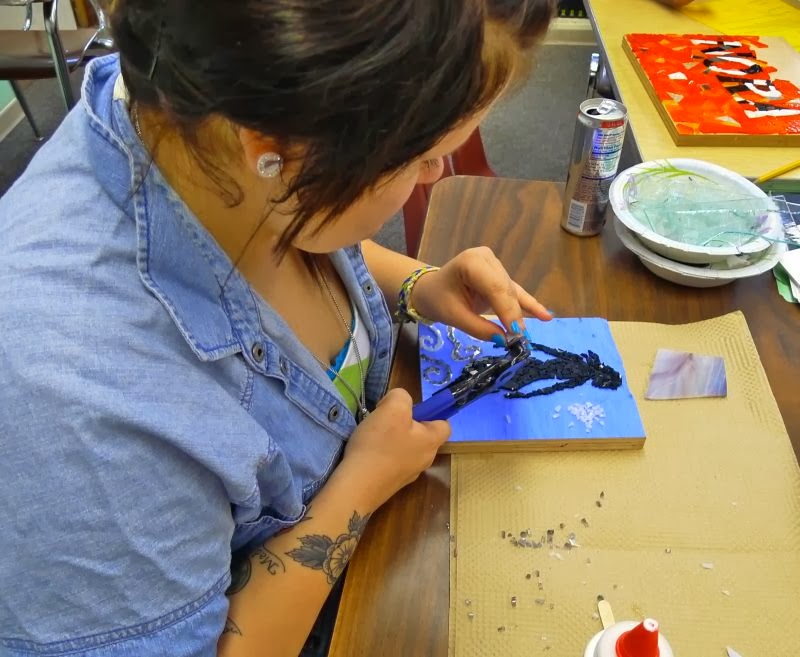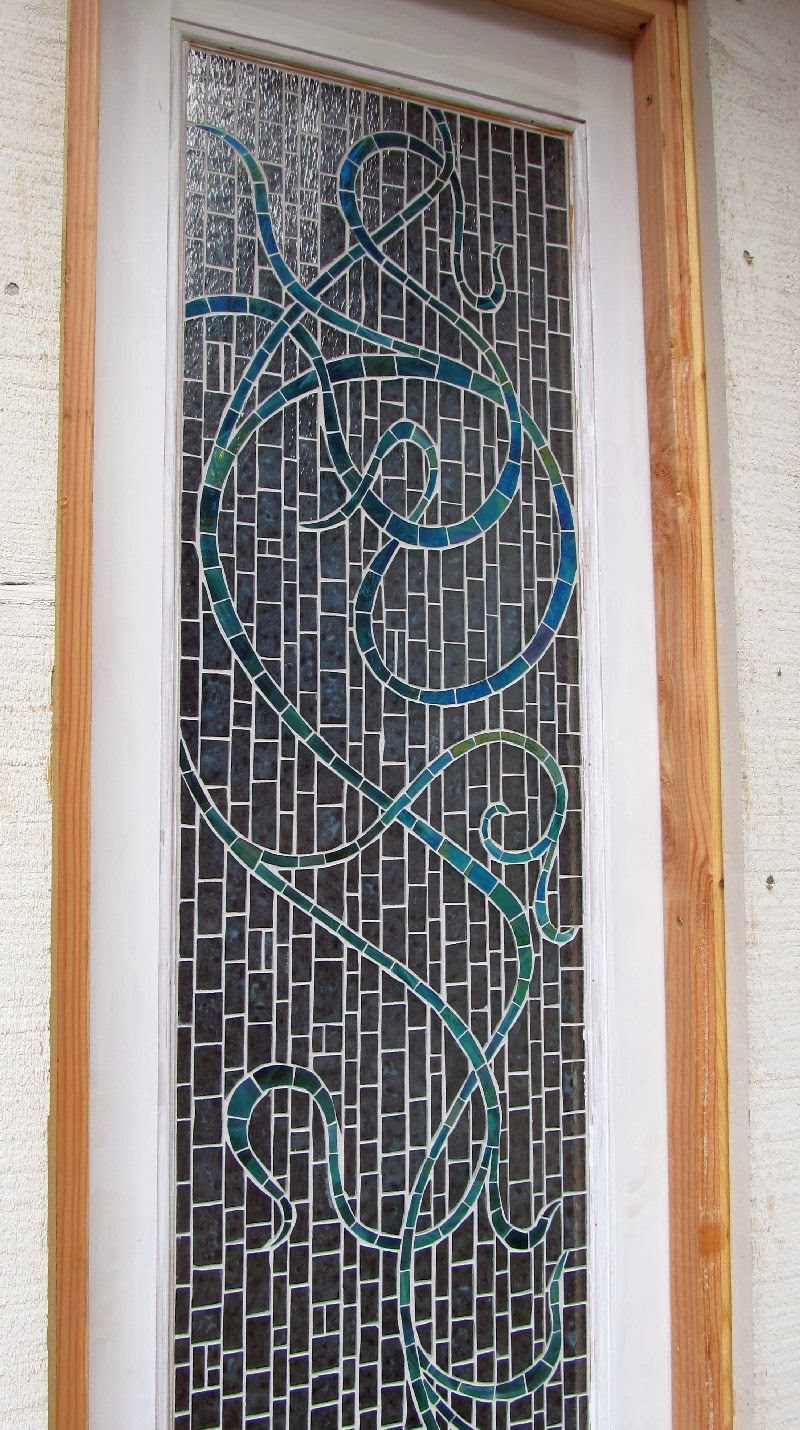Wow, when I logged in here at Blogger, it said that my last post was in February! It makes sense, because my life went a bit haywire in March. That is when a large body-care company asked me to fabricate a mosaic floormat on a very tight deadline. Simultaneously, a close family member began to go through a major crisis, and it all happened within a couple of weeks of a trip to Mexico. I juggled managing and caring for another adult, tending the farm & family, and working 10-12 hour days on that mosaic in order to have it packed and shipped before our trip.
While in Mexico, I learned that the mosaic did not arrive when expected, and had to track it down for the client, and then that it had gotten pretty banged up in transit. This was the first of eleven of those floors, between 11 s.f. and 36 s.f. that I created for that company this year. The third mosaic arrived with about 1/4 of the project missing completely, as in the box must have broken open, the section fell out, and UPS just taped it back up and sent it on it's way. When I requested it be returned for repair, UPS sent it to some kind of inspection center for six days, during which it was unable to locate the package. This was a hugely stressful learning experience, after which I began constructing wood crates for all projects, and will never ship through UPS again. (Their customer service was cold, confused, and unapologetic until my complaint reached a local agent.)
All of the projects created after that arrived intact and, from all I can surmise, were installed without issues. However, working with a big company has been a strange new experience. When the project is confirmed, I hunker down over my work table for long hours every day until it's done, build a crate, ship it off, and I'm lucky if I hear whether it went into place correctly. I have never seen a photo of these floormats after installation, and there is almost no feedback unless something goes wrong.
 |
| The floormat changes in size and composition, but is always this basic design, with the company name along the bottom (not included here.) |
Around July, this company began inquiring about a large-scale mosaic mural, brainstorming how it would be created and installed. They wished for me to do the installation, so I began to consider the best way to construct this kind of mosaic. But, there were delays getting started, my initial bid was too high for the construction budget, and we negotiated until an agreement was reached. By the end of August, the mural was approved, and I began to plan while waiting for the deposit. Originally, I requested two months to create the project. There were some delays, and I said I needed a minimum of six weeks, and I was very nervous that I would not be able to complete a 71 s.f. mosaic within that time - I usually set aside six weeks for a small scale mosaic commission to allow for unforeseen circumstances.
The deposit came through, so I ordered all materials and rearranged my studio to make room for such a large mosaic project. But then the contractor alerted us that there had to be changes to the building facade, and the new measurements were uncertain. As this delay continued, I became more and more panicked. Finally, I convinced the project manager to allow me to have the pattern (a photograph provided by the company) printed to the original scale, and I would adjust after final measurements were confirmed. At this point, I had exactly three weeks to piece the mosaic together before prepping it for installation, crating, and shipping.
Kory Dollar, a mosaic artist in Vancouver, WA, offered to spend a weekend helping me. We had never worked together, and I've never had another artist work on one of my private commissions, but I was desperate, and I would not have met the deadline without her help. A friend of mine with glass-cutting skills, but very little mosaic experience, pieced together the whole green section of a mountain, house, and shrubbery.
 |
| Here's Tara, just starting the mountain range. |
During the weeks of working on this mosaic, I regretted accepting the commission, or not cancelling when there were delays. But, I had received money, purchased materials, and if I could actually complete it, I would receive a satisfactory final payment and have a nice mural in my portfolio. My fear was that it would not be work I could feel proud of, that I would not be able to complete it on time, and that the installation would be so rushed that it would go horribly wrong. I requested an extension, but was denied. The new store is part of a whole shopping center, and the entire place had to be completed and open by the end of October.
This was a very hard time for my family. My daughter is 11, and being unsupervised for hours every day meant that there were daily issues, like an entire bag of marshmallows (meant for occasional bonfires) being eaten in an afternoon, no limits on t.v., homework not being completed - it was a free-for-all. It was harvest season, and the fresh food in the garden rotted in place. Normally, this food is preserved and used throughout the coming year. Honey was not harvested. The barn and coop did not get cleaned and the animals were neglected. I lost all but one duck to predators. We canceled our anniversary plans and I spent no time with my family, which caused stress and resentment. (My daughter is still mad at me.) We ate a lot of take-out and processed food, and instead of getting any exercise at all, I spend long hours bent over, straining my wrists and back to reach areas of the mosaic, and destroying my hands with repetitive motion.
 |
| Completed mosaic assembled on my floor, before prepping for installation. |
The most brilliant move I made during this process was to ask my mosaic colleague in Denver, Krystie Rose Millich, if she would be my installation assistant. We met at a mosaic summit in Chicago many years ago and had an instant connection. Since then, we've roomed together at the conferences and traveled to a workshop together, so I know we are compatible. As it turned out, she was eager to join forces and she was the perfect assistant. She even took on researching and scheduling flights, rental car and hotel. We both flew to Atlanta and arrived within a half hour of each other, picked up a car, and found the hotel the afternoon before we needed to be on the job site. We went to visit the store, which turned out to be a very good decision, as getting in and out of the giant construction zone would be challenging, and we started work knowing what we were in for. We hit Home Depot that night to stock up on all of the things I didn't want to haul in my suitcase. And we tried to get to sleep as early as possible, despite a 3-hour time change and my high level of anxiety, which was making me nauseous. I couldn't stop imagining how I would problem-solve every possible scenario. What if I opened the crates to find sections damaged? What if the mural didn't fit correctly? I couldn't turn my brain off even though I had been awake for 26 hours at that point, flying across the country.
But, on Friday morning, we dragged ourselves out of bed, grabbed breakfast and caffeine, and went to the job site. There may have been one other woman in sight, and we got a lot of odd looks from the hundreds of male construction workers, as if they thought we might be lost. The G.C. helped us to get all of our stuff up onto the scaffolding - which was much higher than I expected. There were some details to go over with the guys to make sure everything squared up before we began dry-setting the mosaic, which took the first half of the day.
I had cut 1/8" wedi into sections, and adhered the mural to the wedi with Laticrete Platinim 254 thinset. I used white thinset because a lot of my glass was translucent. Then, I grouted the sections up to the edges. After dry-setting and making sure everything fit correctly - and it did! - we used locktite construction adhesive and screws to attach the sections to the exterior-grade plywood substrate.
 |
| This photo was taken by a news photographer, Jonathan Phillips. |
There were some glitches. While I had no problem interlocking the sections on the floor in my house, it was different on a vertical surface, and impossible where it had to be inset at the end. I had to bust a lot of pieces off where the seams met, and I found that I had to score and break a lot of the long, flowing sky pieces. So, we spent the last hours of the first day patching the mosaic with thinset and caulking the edges to fill some large gaps. As it began to get dark, we packed up and left. It had been very hard work, climbing up and down that scaffolding, being in very hot sun all day, and doing a lot of lifting and bending. But, I was absolutely elated that none of my fears had come true. Everything had gone about as smoothly as could be expected, given the circumstances.
On Saturday, we were sore and still exhausted, so we managed to drag ourselves to the store around 8:30, long after the other workers had started. But, we knew we would finish by that afternoon. We had to do some more patching in the morning. We broke for lunch and to let the thinset set up. (Normally, I would not grout over fresh thinset, but it was necessary.) After lunch, we grouted all of the seams and edges. In direct Atlanta sun, the grout was setting up very quickly, so Krystie Rose mainly kept up with sponging and wiping while I applied grout. And, by 3pm, with aching arms, we cleaned everything up and left. Immediately after we got to the ground, a pair of workers who had been waiting all day took over the scaffolding, covered the mural with plastic, and began to do stucco work.
And it was done!
And we still had all day Sunday to spare.
Since my return, I have been catching up on everything that was neglected during September & October and making my own designs in mosaic. I'm turning 45 later this month, and I feel compelled to reflect on all that has happened lately, and to look forward. Now that this project is over, I am glad I pushed through it, though I never want to work on such a tight schedule again. But I now have confidence that I can accomplish large projects proficiently. I know what I am capable of, and also what my limits are. This was both an awful and rewarding experience, and I like to think of the quality work I might achieve with more relaxed timelines in the future.
In the meantime, I picked the last tomato from the greenhouse this morning. The goats' hooves are trimmed. I'm catching up on all of the doctor and dentist appointments, cleaning the house, and cooking meals from scratch (usually.) Everything is back in order.














































